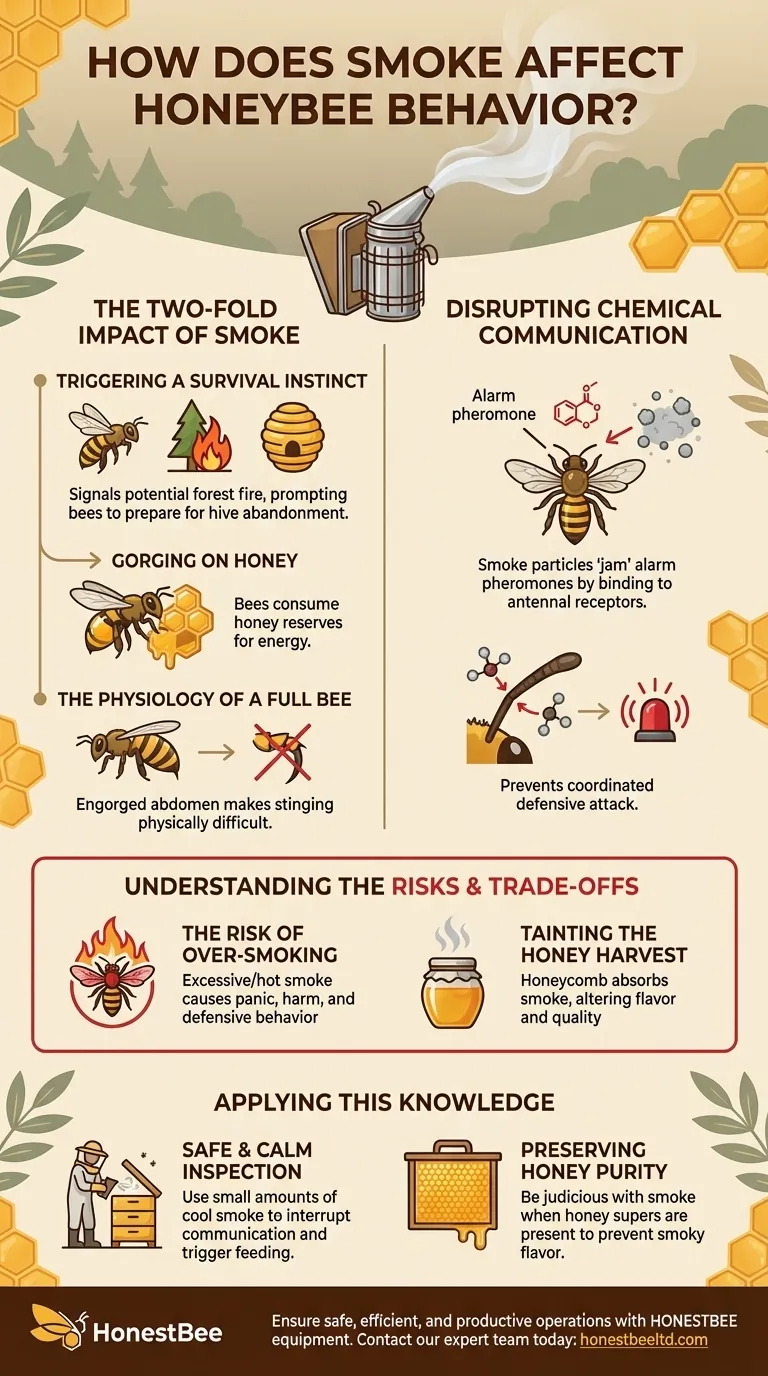The use of smoke in beekeeping is a practice that works by manipulating a honeybee's instinctual and chemical responses to a perceived threat. It pacifies the colony by triggering a survival-driven feeding frenzy and, just as importantly, by scrambling the chemical signals bees use to coordinate a defensive attack.
Smoke does not simply "calm" bees. It effectively short-circuits their defensive systems by creating a false alarm that prompts them to prepare for hive abandonment while simultaneously blocking their ability to communicate the threat to one another.

The Two-Fold Impact of Smoke on Bee Behavior
Smoke's effect on a honeybee colony is not a single action but a dual-pronged disruption. It manipulates both individual bee physiology and the collective's communication network.
Triggering a Survival Instinct
Bees have an ancient, hardwired response to smoke: it signals a potential forest fire. This triggers a specific survival protocol within the hive.
Faced with the possibility of having to abandon their home, bees rush to consume as much honey as possible. This act of gorging on honey is their attempt to carry valuable energy reserves with them to a new location.
The Physiology of a Full Bee
A bee that has just filled its honey stomach is physically less capable of attacking. Its abdomen becomes engorged and difficult to bend into the "C" shape required to aim its stinger effectively.
This physical limitation, combined with the distraction of the feeding response, makes the bees significantly less likely to sting an intruding beekeeper.
Disrupting Chemical Communication
Perhaps the most critical function of smoke is its ability to mask alarm pheromones. When a guard bee perceives a threat, it releases these chemical signals to alert the rest of the colony.
Smoke particles effectively "jam" this signal. The molecules in the smoke bind to the bees' antennal receptors, preventing them from detecting the alarm pheromones released by their hive mates. This stops a defensive response from escalating into a full-blown colony-wide attack.
Understanding the Trade-offs and Risks
While smoke is an invaluable tool, it is not without consequences. Its effectiveness hinges on proper application, and overuse can be counterproductive or even harmful.
The Risk of Over-Smoking
A few cool, gentle puffs of smoke are effective. However, excessive or hot smoke can have the opposite effect.
Too much smoke can cause bees to become agitated and panicked, leading them to flee or become overly defensive. It can also harm the bees' sensitive respiratory systems.
Tainting the Honey Harvest
Honeycomb cappings are permeable, meaning they can absorb vapors and odors from the air.
If a beekeeper uses smoke excessively, especially when honey supers are on the hive, the honey can become tainted with a smoky flavor. Studies confirm that smoke can alter the volatile chemical characteristics of honey, impacting its quality and taste.
Applying This Knowledge to Your Hive
Understanding the "why" behind smoking bees allows for more precise and responsible beekeeping. Your goal dictates your technique.
- If your primary focus is a safe and calm inspection: Use small amounts of cool, white smoke at the entrance and under the lid to interrupt communication and trigger the feeding response before you begin.
- If your primary focus is preserving honey purity: Be extremely judicious with smoke when honey supers are present. Aim to use as little as necessary to maintain control, preventing any smoky flavor from being absorbed.
Ultimately, mastering the use of smoke is about working with the bees' natural instincts, not against them, to achieve a safe and productive outcome for both bee and beekeeper.
Summary Table:
| Effect of Smoke | Key Mechanism | Beekeeper Benefit |
|---|---|---|
| Triggers Feeding Frenzy | Mimics forest fire, prompting bees to gorge on honey | Bees are physically less able to sting |
| Masks Alarm Pheromones | Smoke particles block chemical communication | Prevents coordinated defensive attack |
| Calms the Colony | Disrupts the defensive systems without harming bees | Enables safer hive inspections and management |
Ensure your beekeeping operations are safe, efficient, and productive with the right equipment from HONESTBEE.
As a leading wholesale supplier to commercial apiaries and distributors, we understand that effective hive management is the foundation of your success. Our high-quality smokers and protective gear are designed for professional beekeepers who demand reliability and performance.
Let HONESTBEE equip your business with durable, effective tools that work in harmony with bee behavior.
Contact our expert team today to discuss your wholesale needs and discover how our products can support the scale and safety of your operations.
Visual Guide

Related Products
- Premium Traditional Copper Bee Smoker with Bellows
- European Stainless Steel Bee Smoker for Honey Bee Hive
- Stainless Steel Honey Bee Smoker Hive and Honeycomb Smoker for Beekeeping
- Electric Bee Smoker European Style Bee Hive Smoker for Beekeeping
- Economy Galvanized Beekeeping Honey Bee Smoker for Wholesale
People Also Ask
- What is the primary purpose of using smoke in beekeeping? Calm Bees for Safer Hive Management
- What is a Smoker and how is it used in beekeeping? The Essential Tool for Calm, Safe Hive Inspections
- What are the main components of a bee smoker? A Guide to Safe and Effective Hive Management
- What are the main parts of a bee smoker? Essential Components for Calm Hive Management
- What happens to bees when they sense smoke? Unlock the Secret to Calm Hive Inspections



















